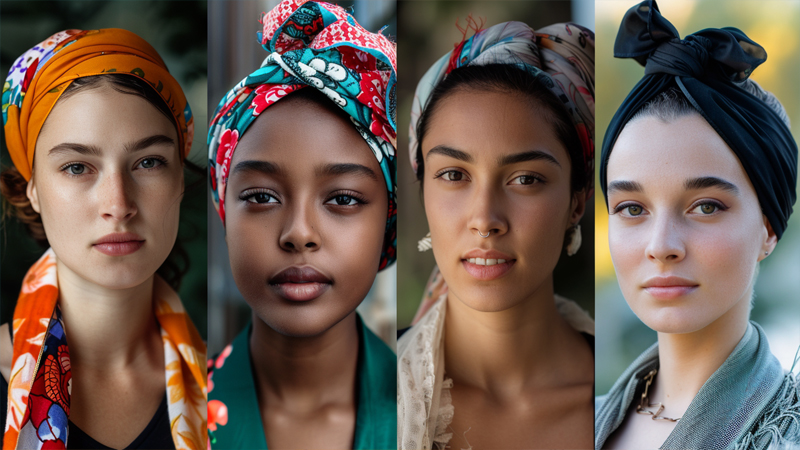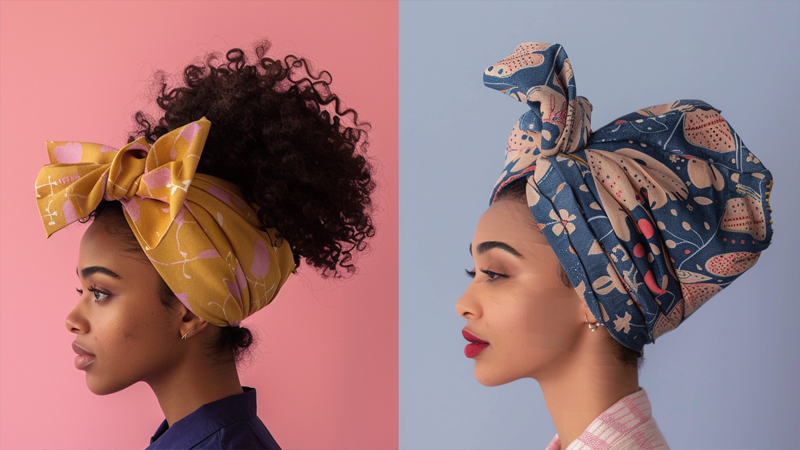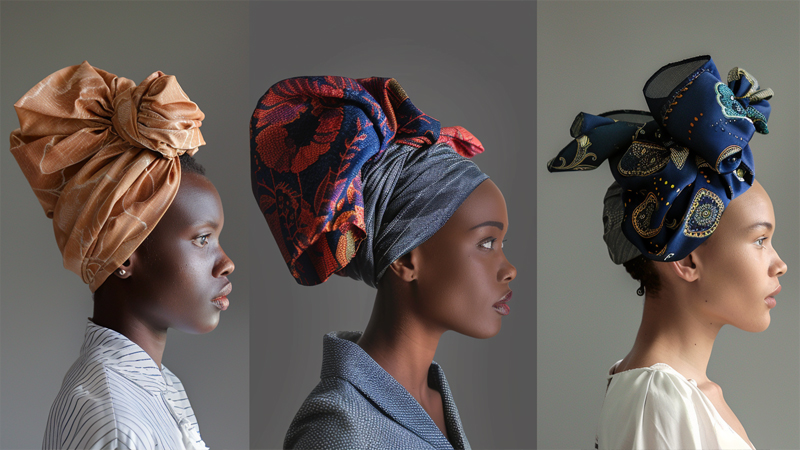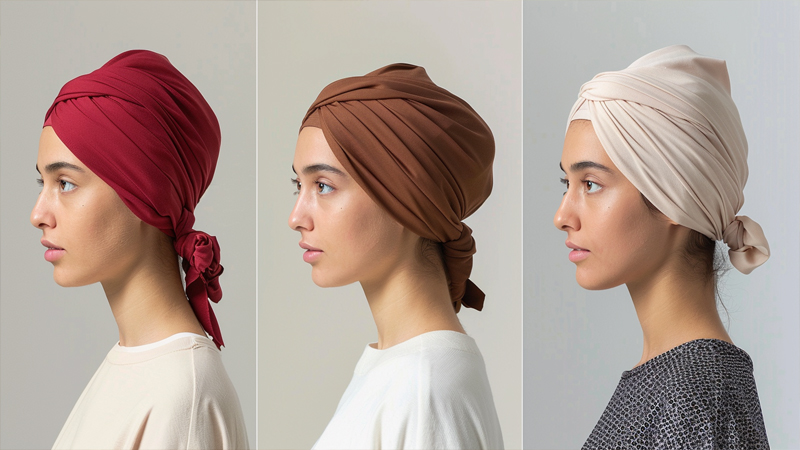
I still remember discovering wired head wraps and wondering how a tiny wire could transform a simple piece of fabric.
Wired head wraps contain flexible wiring for shaping, while headscarves and turbans rely on fabric folds or knots to secure.
Let’s see how they compare.
What are the structural differences between wired and non-wired head wraps?
Wired wraps have built-in wire, unlike headscarves and turbans that rely on fabric alone.
A wire lets you shape your wrap more precisely, whereas non-wired styles depend on tying and folding.

I remember the first time I tried a wired head wrap1. I was skeptical, but it felt like I had an instant styling secret hidden within the cloth. The wire helped hold a perfect bow shape, even on a breezy day. In contrast, a typical headscarf relies on tension from the knot itself or a few hairpins for stability. Turbans usually involve twists and tucks of the fabric to stay put, which can be incredibly secure but requires a bit of practice.
Wired wraps tend to use a thin, flexible wire running along the edges or center. This design makes shaping easier, much like bending a pipe cleaner into any form you like. Headscarves, on the other hand, are completely fabric-based, so you have to rely on your tying skills—and sometimes a clever fold—to achieve a neat shape. Meanwhile, turbans often come in a stitched shape (pre-tied) or require wrapping the fabric around your head, providing a structured look without visible wiring.
The Freedom of Wire
A wire can simplify certain styles. For instance, if you want a big bow on top, wired edges let you create crisp loops that hold their form all day. With a non-wired wrap2, you might need multiple knots or pins to keep a bow standing upright. On the flip side, the wire also adds a bit of weight and might press against your head, especially if you tie it tightly. It’s all about balance. I’ve found that for everyday wear, a soft cotton headscarf is enough. But when I’m craving something eye-catching or a bit more creative, a wired wrap offers that extra flair with minimal effort.
What functional uses does each type serve?
Headscarves often protect hair or denote culture, turbans3 offer coverage and style, and wired wraps4 add secure shaping.
Each style can shield from sun, dust, or cold while expressing personal flair and identity.

I’ve noticed that headscarves are frequently chosen for practical reasons. For example, I’ll wear one on a windy day to keep my hair from tangling or to shield my scalp from harsh sunlight. In some cultures, headscarves carry significant meaning—whether it’s about modesty, religious practice, or heritage. Turbans can also serve cultural and religious roles, but they’re equally popular for turning a bad hair day into a fashion statement.
Practical and Cultural Nuances
When you think of turbans, you might picture elaborate wraps worn in formal ceremonies. But I’ve also seen casual turban styles that people use to keep curls protected overnight or to quickly style hair on a rushed morning. Wired wraps, however, feel more fashion-focused to me. Sure, they keep your hair in place, but the wire is mostly about controlling the shape for a bold or artistic twist. If you’re heading to a festival or a fun event, a wired wrap can instantly amplify your outfit.
That’s not to say wired wraps don’t provide practicality. They can offer an extra grip around your hair so it doesn’t slip, especially if you’re moving around a lot. But more often than not, they’re chosen for style-driven goals—like standing out in a crowd or adding that perfect bow on top of a bun. Whether you’re aiming for sun protection, cultural expression, or a statement piece, there’s a head wrap style to meet your needs. I love switching between all three types, depending on what the day calls for: simplicity, tradition, or a bit of drama.
What unique styling options does each type offer?
Wired wraps can form dramatic bows or shapes, headscarves5 adapt to countless ties, and turbans create a regal silhouette.
Embrace playful bends with wires, explore infinite knots with scarves, and enjoy a polished profile with turbans.

When I want to wow people at a party, a wired wrap is my go-to. I’ll twist it into a huge bow off to one side, adding a dash of whimsy that makes folks ask, “How did you do that?” On more casual days, a traditional headscarf might be better—there are so many tying methods, from the classic Rosie the Riveter look to a chic side knot. Turbans, meanwhile, offer a distinctive shape that can come off as both elegant and edgy, depending on your fabric choice.
Exploring Creative Options
- Wired Wraps: Because of their flexible core, you can spiral them into rosettes, form cat ear-like shapes, or even craft a retro headband style with a visible “knot” in front. I’ve found that polka dot patterns or bright colors really bring out the playful side of wired wraps6.
- Headscarves: The sheer variety of ties is mind-blowing. You can fold them into triangles, roll them into narrow bands, or layer multiple scarves for a bohemian vibe. Adding pins, brooches, or small flowers can personalize the style further.
- Turbans: Some designs are pre-tied, making them an instant fix for busy mornings. Others let you wrap the fabric around your head in intricate ways, often forming knots or layered folds at the front or back. A velvet or satin turban can be perfect for special events, whereas a simple cotton or jersey version might be your best friend on a laid-back weekend.
No matter which style you choose, each offers a fresh canvas to highlight your personality. You can coordinate them with your outfit, experiment with prints and fabrics, or even switch them up throughout the day if you feel inspired. I once went from a wired wrap during a daytime picnic to a sleek turban for a classy dinner—all without changing my makeup or outfit. The difference was just in the wrap, which shows how transformative these head accessories can be.
What comfort and wearability considerations exist for each type?
Wired wraps can feel snug, turbans provide full coverage, and scarves need secure knots.
Choose a style that balances grip and breathability, keeping in mind fabric thickness and personal comfort.

Comfort often boils down to how the wrap feels on your head and scalp. A wired wrap can feel slightly stiff, especially if you tie it tightly to hold a shape. However, that same wire gives you control over tightness. If it’s pinching, you can usually adjust it without redoing the entire wrap. Turbans, especially the pre-tied kind, can be super comfortable if they’re made from soft, stretchy material. They stay in place without the worry of knots loosening. But if your turban is on the tighter side, it might lead to a bit of pressure on your forehead after hours of wear.
Finding Your Perfect Fit
- Wired Wraps: Light materials help reduce heat buildup, while adjustable wire tension allows you to loosen or tighten the fit.
- Headscarves: Fabric choice is key—breathable cotton or linen scarves7 are great for hotter climates, while satin or silk are gentler on hair. Make sure to tie knots firmly but not so tight that you feel a headache coming on.
- Turbans: If you opt for a pre-tied version, check if it has an elastic band for a comfortable stretch. For wrap-style turbans, practice different tying methods to find one that won’t slip or feel too constricting.
I’ve had moments where a scarf was too tight, leaving a red mark on my forehead by day’s end. On the flipside, a loose wrap might slip off with the slightest movement, especially if you have silky or fine hair. One trick is to wear an under-cap or headband beneath your chosen wrap, giving the fabric something to grip. Ultimately, it’s about adjusting as you go. If I know I’ll be out all day, I pick a wrap that breathes well and doesn’t need constant readjustment. Meanwhile, for short events or a photo-worthy occasion, I might trade some comfort for a more elaborate style. The great thing is, once you’ve tried them all—wired, scarf, turban—you’ll discover which fits each part of your life best.
Conclusion
Whether wired, scarf, or turban, each head wrap style offers its own blend of flair, function, and comfort.
-
Discover how a wired head wrap can offer superior shaping and styling versatility compared to traditional headscarves and turbans. ↩
-
Learn the art of styling non-wired wraps with expert tips on tying and folding for a secure and fashionable look. ↩
-
Understanding the dual role of turbans in culture and fashion can enhance appreciation for their versatility and style. ↩
-
Discovering the unique combination of style and functionality in wired wraps can inspire innovative ways to accessorize and protect your hair. ↩
-
Learn a variety of headscarf tying techniques to match any occasion, from casual outings to chic events. ↩
-
Discover creative and whimsical ways to style wired wraps that will make you the center of attention at any party. ↩
-
Discover the advantages of breathable cotton or linen scarves, especially for comfort in hotter climates, ensuring a pleasant wearing experience. ↩




